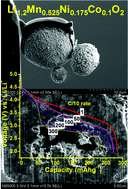Solid electrolyte coated high voltage layered–layered lithium-rich composite cathode: Li1.2Mn0.525Ni0.175Co0.1O2†
Abstract
The electrochemical rate performance and capacity retention of the “layered–layered” lithium rich Li1.2Mn0.525Ni0.175Co0.1O2 (Li-rich NMC) material are significantly improved by a nanometer layer coating of a lithium conducting solid electrolyte, lithium phosphorus oxynitride (LiPON). The LiPON layer is deposited on the Li-rich NMC particles by the RF-magnetron sputtering method. The presence of the LiPON layer provides interfacial stability under high current (rate) and voltage cycling conditions and thereby improves the capacity retention over cycle life compared to pristine or uncoated Li-rich NMC. Specifically, the LiPON coated Li-rich NMC composite


 Please wait while we load your content...
Please wait while we load your content...